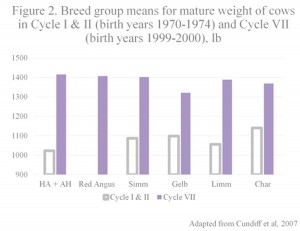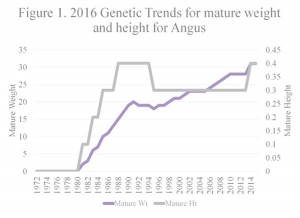by Sandy Johnson, livestock specialist
The Beef Improvement Federation meetings were hosted by Kansas State University in Manhattan, June 15-17. If you missed this meeting, you might want to check out the online coverage provided by Angus Productions, Inc. at
www.bifconference.com. In the newsroom you will find links to proceedings, presentations and audio. More material will be posted in the future.
One of the more interesting discussions for me was the second general session on Thursday morning that revolved around the cowherd and cow efficiency. Feed cost associated with maintaining cows accounts for 60 to 75% of the total feed cost of the herd. This makes maintenance energy requirements economically important and the trait has also been shown to be highly heritable (h2=0.52).
Key factors impacting maintenance energy requirements are mature cow weight, height and body condition score. Milk production also influences energy requirements but it accounts for less than a tenth as much variability in maintenance energy as mature size. Maintenance energy EPD are available in many breeds but differ in construction and thus interpretation, (higher isn’t better in all cases).
 Genetic trends show a clear increase in mature cow size in Angus (Figure 1) and other breeds have changed as well (Figure 2). As important as cow size is to feed costs and profitability of the industry, breed associations report that they only receive 2 to 5 mature cow weights for every 100 weaning weights submitted. This lack of information results in much lower accuracy for EPDs that will slow any genetic change.
Genetic trends show a clear increase in mature cow size in Angus (Figure 1) and other breeds have changed as well (Figure 2). As important as cow size is to feed costs and profitability of the industry, breed associations report that they only receive 2 to 5 mature cow weights for every 100 weaning weights submitted. This lack of information results in much lower accuracy for EPDs that will slow any genetic change.
I commend those in the seedstock industry that do report cow body weights and body condition scores and submit reports on all their cows (whole herd reporting). Commercial producers should en-courage their genetic suppliers to do so if they aren’t already and make sure they take the same measures on their commercial cows.
Knowledge of body weight for all classes of cattle is important for accurately dosing anthelmintics and antibiotics. Under dosing may result in no improvement in the condition that warranted the treatment while still incurring the treatment cost and lead to the development of resistance. Overdosing is expensive and could alter any needed withdrawal times.
You can’t manage what you don’t measure. Cow body weight and body condition score impact maintenance energy requirements, feed cost and profitability.
